Balanced Fund
VerifiedAdded on 2023/06/07
|15
|3305
|227
AI Summary
The Balanced Investment portfolio was constructed using the notional amount of $A1 billion, which was diversified with the preference of the investors. The type of investor studied for this type of fund is the moderate risk averse investors whose risk preference towards the assets is inclined by the amount of the return the assets class generates. The wide class of investment, which were considered for investing, were the cash and cash equivalents, fixed deposits domestic, fixed deposits in overseas, equity investment, real estate and private equity were the type of assets class selected. The whole portfolio was viewed from the context of equity and debt investment.
Contribute Materials
Your contribution can guide someone’s learning journey. Share your
documents today.
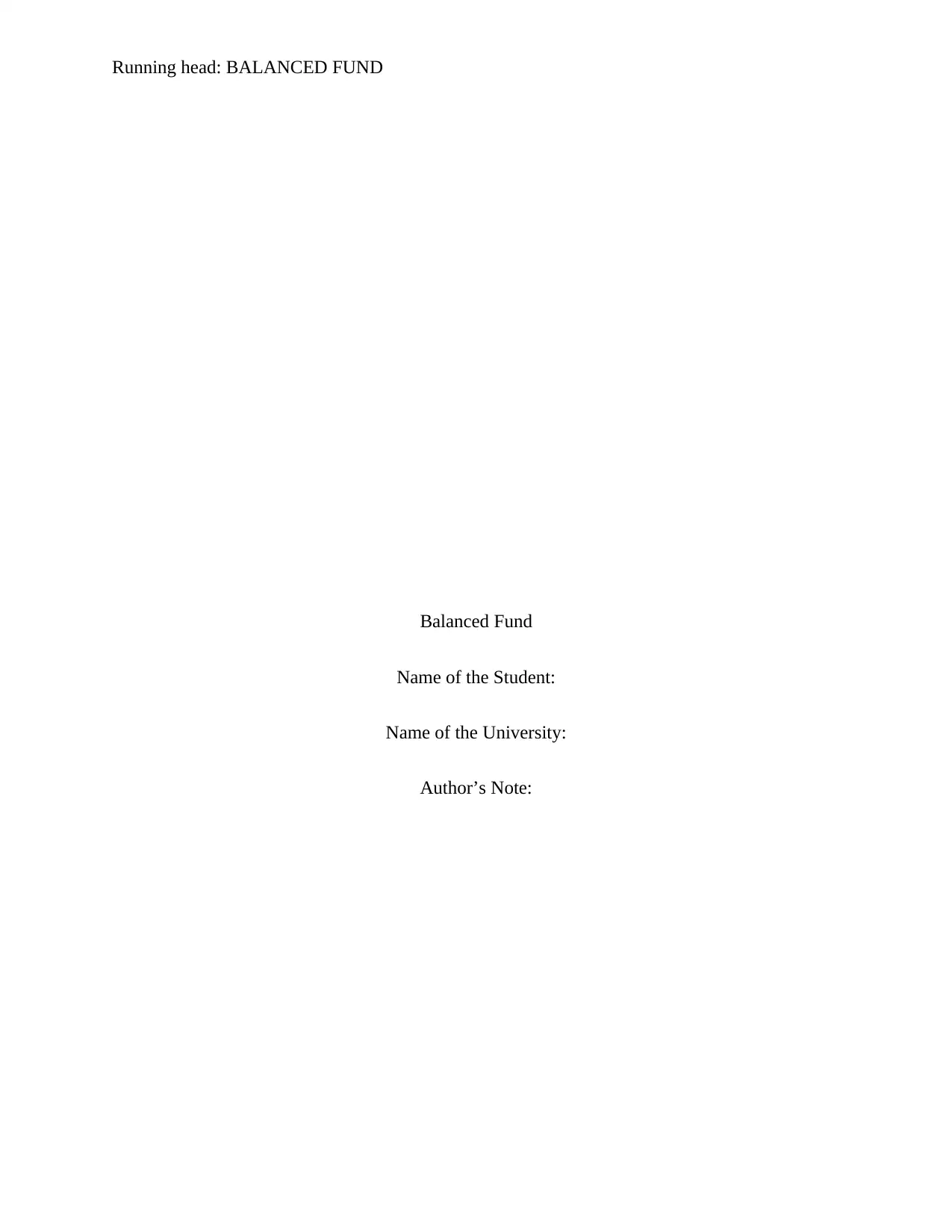
Running head: BALANCED FUND
Balanced Fund
Name of the Student:
Name of the University:
Author’s Note:
Balanced Fund
Name of the Student:
Name of the University:
Author’s Note:
Secure Best Marks with AI Grader
Need help grading? Try our AI Grader for instant feedback on your assignments.
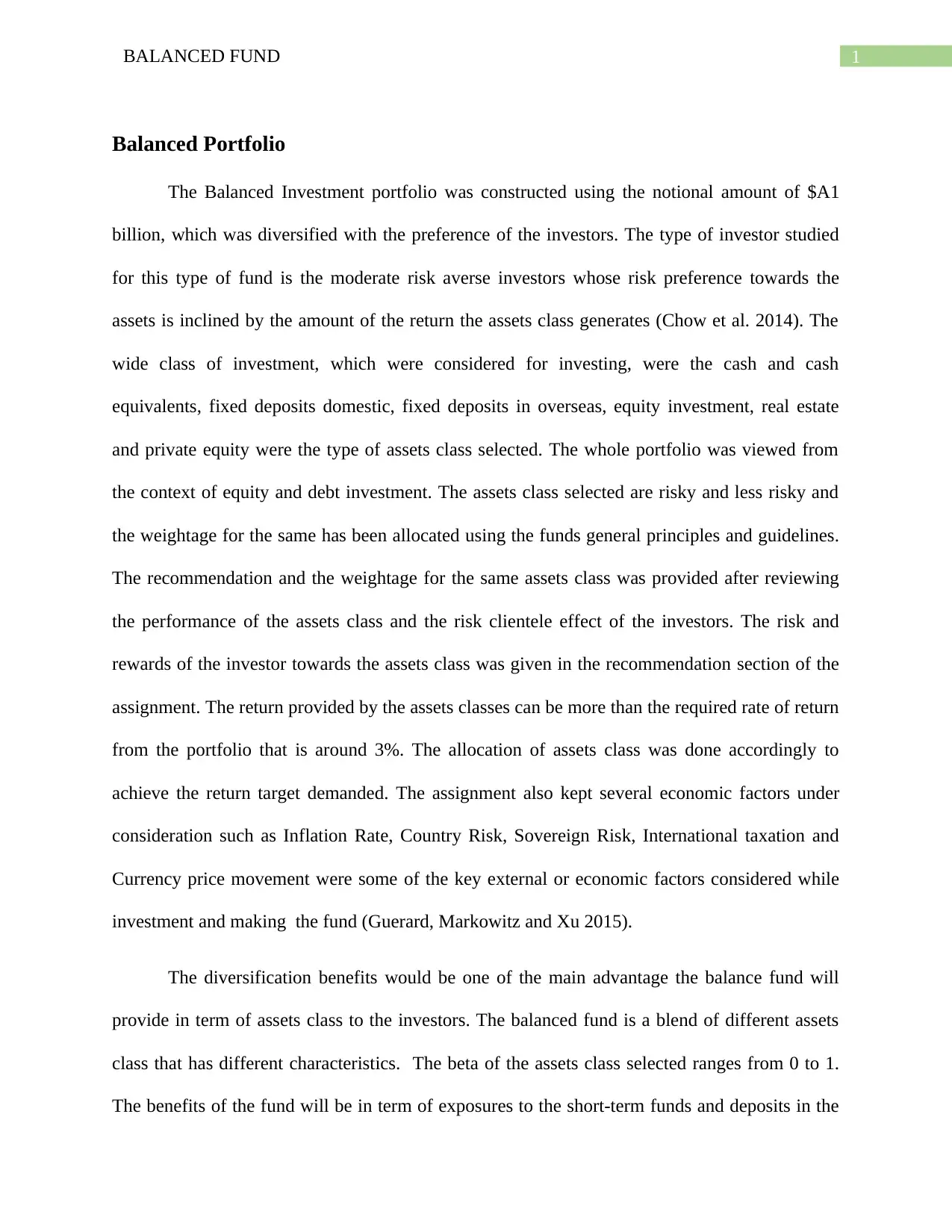
1BALANCED FUND
Balanced Portfolio
The Balanced Investment portfolio was constructed using the notional amount of $A1
billion, which was diversified with the preference of the investors. The type of investor studied
for this type of fund is the moderate risk averse investors whose risk preference towards the
assets is inclined by the amount of the return the assets class generates (Chow et al. 2014). The
wide class of investment, which were considered for investing, were the cash and cash
equivalents, fixed deposits domestic, fixed deposits in overseas, equity investment, real estate
and private equity were the type of assets class selected. The whole portfolio was viewed from
the context of equity and debt investment. The assets class selected are risky and less risky and
the weightage for the same has been allocated using the funds general principles and guidelines.
The recommendation and the weightage for the same assets class was provided after reviewing
the performance of the assets class and the risk clientele effect of the investors. The risk and
rewards of the investor towards the assets class was given in the recommendation section of the
assignment. The return provided by the assets classes can be more than the required rate of return
from the portfolio that is around 3%. The allocation of assets class was done accordingly to
achieve the return target demanded. The assignment also kept several economic factors under
consideration such as Inflation Rate, Country Risk, Sovereign Risk, International taxation and
Currency price movement were some of the key external or economic factors considered while
investment and making the fund (Guerard, Markowitz and Xu 2015).
The diversification benefits would be one of the main advantage the balance fund will
provide in term of assets class to the investors. The balanced fund is a blend of different assets
class that has different characteristics. The beta of the assets class selected ranges from 0 to 1.
The benefits of the fund will be in term of exposures to the short-term funds and deposits in the
Balanced Portfolio
The Balanced Investment portfolio was constructed using the notional amount of $A1
billion, which was diversified with the preference of the investors. The type of investor studied
for this type of fund is the moderate risk averse investors whose risk preference towards the
assets is inclined by the amount of the return the assets class generates (Chow et al. 2014). The
wide class of investment, which were considered for investing, were the cash and cash
equivalents, fixed deposits domestic, fixed deposits in overseas, equity investment, real estate
and private equity were the type of assets class selected. The whole portfolio was viewed from
the context of equity and debt investment. The assets class selected are risky and less risky and
the weightage for the same has been allocated using the funds general principles and guidelines.
The recommendation and the weightage for the same assets class was provided after reviewing
the performance of the assets class and the risk clientele effect of the investors. The risk and
rewards of the investor towards the assets class was given in the recommendation section of the
assignment. The return provided by the assets classes can be more than the required rate of return
from the portfolio that is around 3%. The allocation of assets class was done accordingly to
achieve the return target demanded. The assignment also kept several economic factors under
consideration such as Inflation Rate, Country Risk, Sovereign Risk, International taxation and
Currency price movement were some of the key external or economic factors considered while
investment and making the fund (Guerard, Markowitz and Xu 2015).
The diversification benefits would be one of the main advantage the balance fund will
provide in term of assets class to the investors. The balanced fund is a blend of different assets
class that has different characteristics. The beta of the assets class selected ranges from 0 to 1.
The benefits of the fund will be in term of exposures to the short-term funds and deposits in the
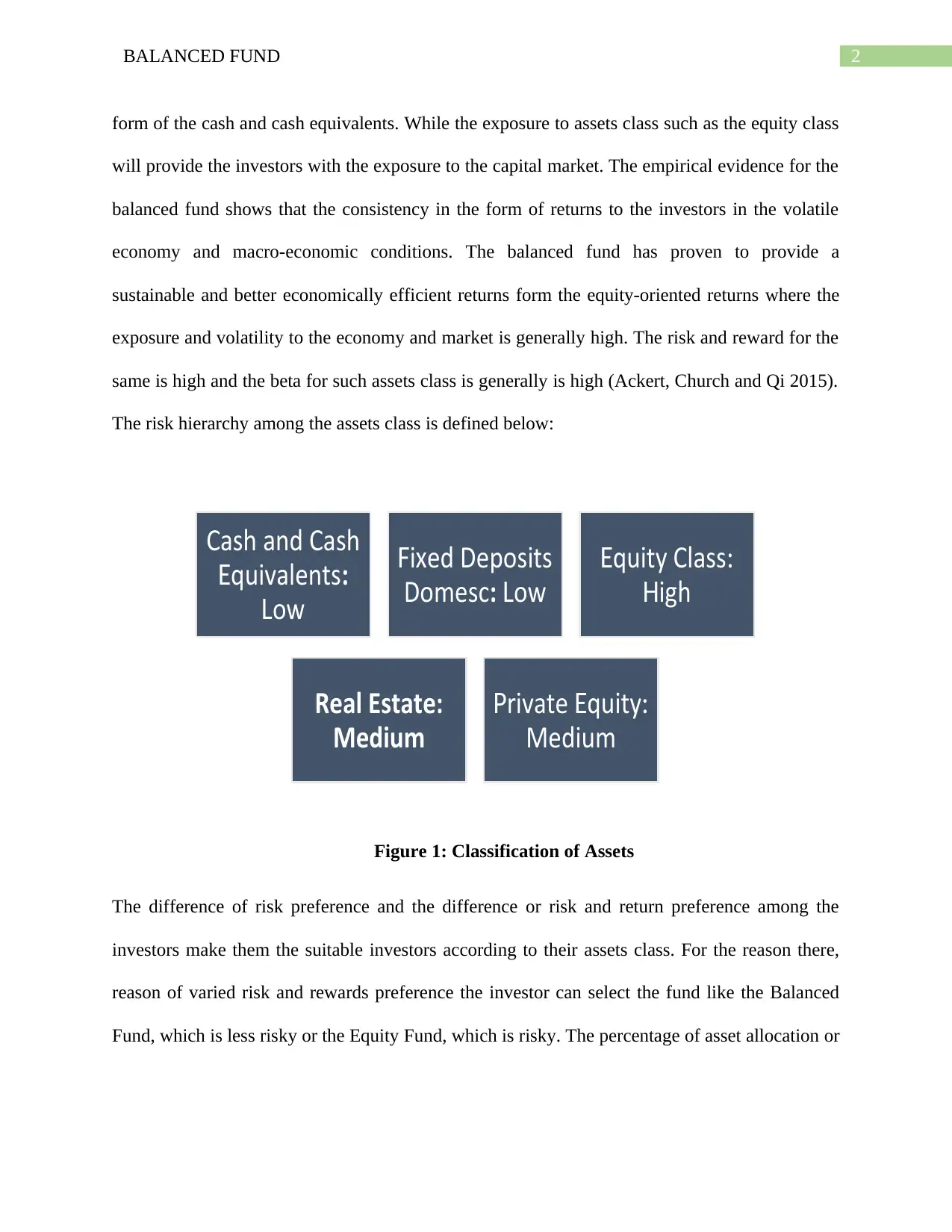
2BALANCED FUND
form of the cash and cash equivalents. While the exposure to assets class such as the equity class
will provide the investors with the exposure to the capital market. The empirical evidence for the
balanced fund shows that the consistency in the form of returns to the investors in the volatile
economy and macro-economic conditions. The balanced fund has proven to provide a
sustainable and better economically efficient returns form the equity-oriented returns where the
exposure and volatility to the economy and market is generally high. The risk and reward for the
same is high and the beta for such assets class is generally is high (Ackert, Church and Qi 2015).
The risk hierarchy among the assets class is defined below:
Figure 1: Classification of Assets
The difference of risk preference and the difference or risk and return preference among the
investors make them the suitable investors according to their assets class. For the reason there,
reason of varied risk and rewards preference the investor can select the fund like the Balanced
Fund, which is less risky or the Equity Fund, which is risky. The percentage of asset allocation or
Cash and Cash
quivalentsE :
owL
i ed DepositsF x
Domestic: owL
quity ClassE :
ighH
Real Estate:
Medium
rivate quityP E :
Medium
form of the cash and cash equivalents. While the exposure to assets class such as the equity class
will provide the investors with the exposure to the capital market. The empirical evidence for the
balanced fund shows that the consistency in the form of returns to the investors in the volatile
economy and macro-economic conditions. The balanced fund has proven to provide a
sustainable and better economically efficient returns form the equity-oriented returns where the
exposure and volatility to the economy and market is generally high. The risk and reward for the
same is high and the beta for such assets class is generally is high (Ackert, Church and Qi 2015).
The risk hierarchy among the assets class is defined below:
Figure 1: Classification of Assets
The difference of risk preference and the difference or risk and return preference among the
investors make them the suitable investors according to their assets class. For the reason there,
reason of varied risk and rewards preference the investor can select the fund like the Balanced
Fund, which is less risky or the Equity Fund, which is risky. The percentage of asset allocation or
Cash and Cash
quivalentsE :
owL
i ed DepositsF x
Domestic: owL
quity ClassE :
ighH
Real Estate:
Medium
rivate quityP E :
Medium
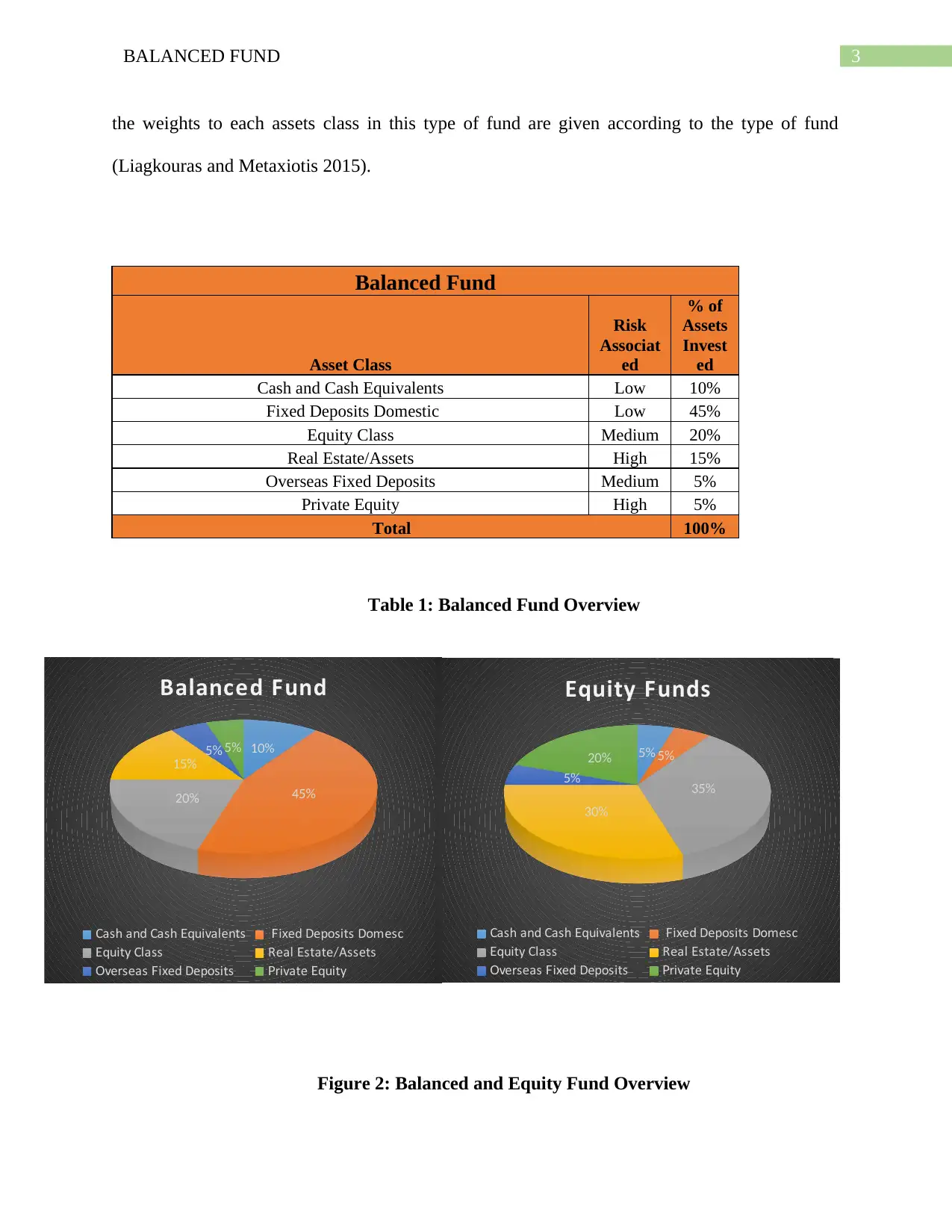
3BALANCED FUND
the weights to each assets class in this type of fund are given according to the type of fund
(Liagkouras and Metaxiotis 2015).
Balanced Fund
Asset Class
Risk
Associat
ed
% of
Assets
Invest
ed
Cash and Cash Equivalents Low 10%
Fixed Deposits Domestic Low 45%
Equity Class Medium 20%
Real Estate/Assets High 15%
Overseas Fixed Deposits Medium 5%
Private Equity High 5%
Total 100%
Table 1: Balanced Fund Overview
Figure 2: Balanced and Equity Fund Overview
10%
45%20%
15% 5% 5%
Balanced Fund
Cash and Cash quivalentsE i ed Deposits DomesticF x
quity ClassE Real state AssetsE /
verseas i ed DepositsO F x rivate quityP E
5% 5%
35%
30%
5%
20%
Equity Funds
Cash and Cash quivalentsE i ed Deposits DomesticF x
quity ClassE Real state AssetsE /
verseas i ed DepositsO F x rivate quityP E
the weights to each assets class in this type of fund are given according to the type of fund
(Liagkouras and Metaxiotis 2015).
Balanced Fund
Asset Class
Risk
Associat
ed
% of
Assets
Invest
ed
Cash and Cash Equivalents Low 10%
Fixed Deposits Domestic Low 45%
Equity Class Medium 20%
Real Estate/Assets High 15%
Overseas Fixed Deposits Medium 5%
Private Equity High 5%
Total 100%
Table 1: Balanced Fund Overview
Figure 2: Balanced and Equity Fund Overview
10%
45%20%
15% 5% 5%
Balanced Fund
Cash and Cash quivalentsE i ed Deposits DomesticF x
quity ClassE Real state AssetsE /
verseas i ed DepositsO F x rivate quityP E
5% 5%
35%
30%
5%
20%
Equity Funds
Cash and Cash quivalentsE i ed Deposits DomesticF x
quity ClassE Real state AssetsE /
verseas i ed DepositsO F x rivate quityP E
Secure Best Marks with AI Grader
Need help grading? Try our AI Grader for instant feedback on your assignments.
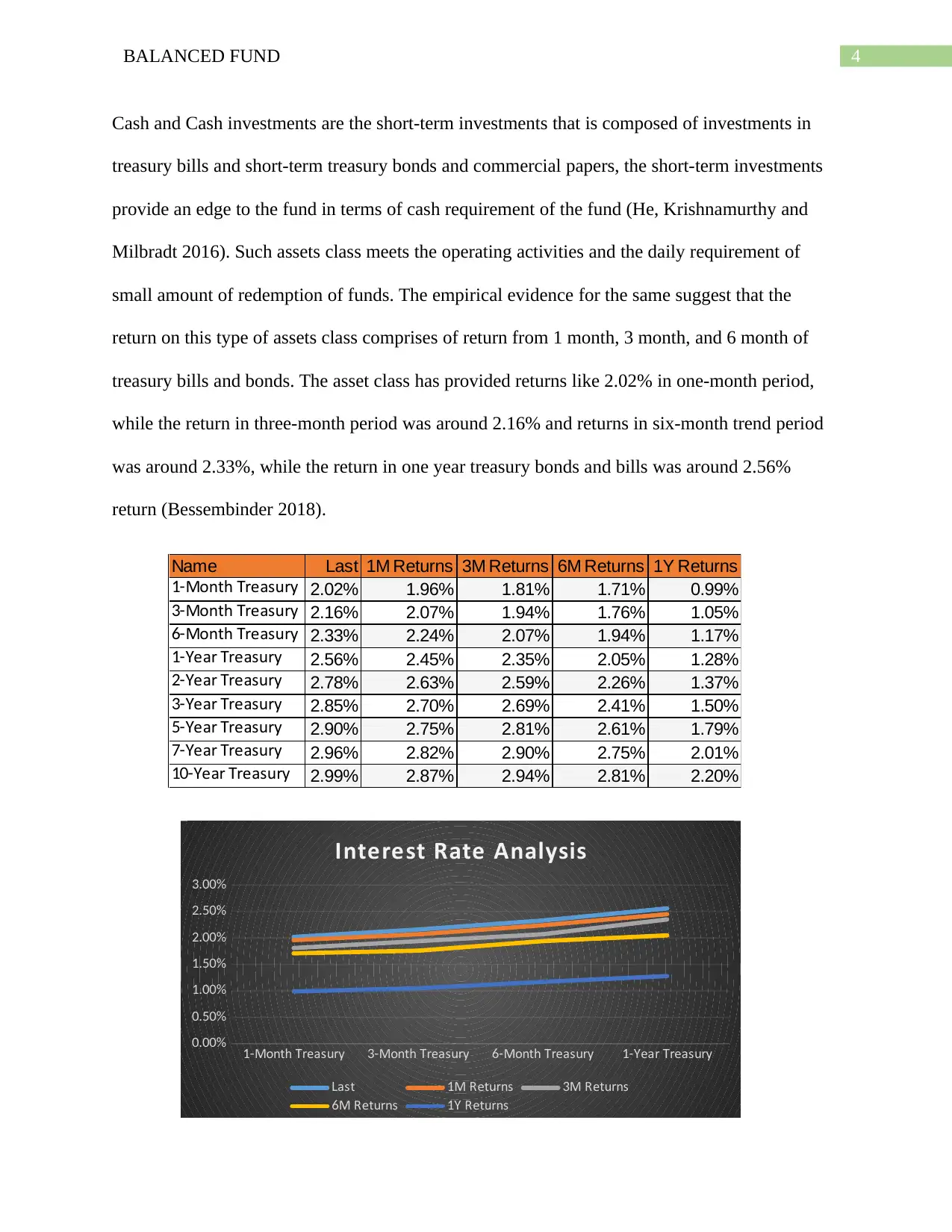
4BALANCED FUND
Cash and Cash investments are the short-term investments that is composed of investments in
treasury bills and short-term treasury bonds and commercial papers, the short-term investments
provide an edge to the fund in terms of cash requirement of the fund (He, Krishnamurthy and
Milbradt 2016). Such assets class meets the operating activities and the daily requirement of
small amount of redemption of funds. The empirical evidence for the same suggest that the
return on this type of assets class comprises of return from 1 month, 3 month, and 6 month of
treasury bills and bonds. The asset class has provided returns like 2.02% in one-month period,
while the return in three-month period was around 2.16% and returns in six-month trend period
was around 2.33%, while the return in one year treasury bonds and bills was around 2.56%
return (Bessembinder 2018).
Name Last 1M Returns 3M Returns 6M Returns 1Y Returns
Month reasury1- T 2.02% 1.96% 1.81% 1.71% 0.99%
Month reasury3- T 2.16% 2.07% 1.94% 1.76% 1.05%
Month reasury6- T 2.33% 2.24% 2.07% 1.94% 1.17%
ear reasury1-Y T 2.56% 2.45% 2.35% 2.05% 1.28%
ear reasury2-Y T 2.78% 2.63% 2.59% 2.26% 1.37%
ear reasury3-Y T 2.85% 2.70% 2.69% 2.41% 1.50%
ear reasury5-Y T 2.90% 2.75% 2.81% 2.61% 1.79%
ear reasury7-Y T 2.96% 2.82% 2.90% 2.75% 2.01%
ear reasury10-Y T 2.99% 2.87% 2.94% 2.81% 2.20%
Month reasury1- T Month reasury3- T Month reasury6- T ear reasury1-Y T
0.00%
0.50%
1.00%
1.50%
2.00%
2.50%
3.00%
Interest Rate Analysis
astL M Returns1 M Returns3
M Returns6 Returns1Y
Cash and Cash investments are the short-term investments that is composed of investments in
treasury bills and short-term treasury bonds and commercial papers, the short-term investments
provide an edge to the fund in terms of cash requirement of the fund (He, Krishnamurthy and
Milbradt 2016). Such assets class meets the operating activities and the daily requirement of
small amount of redemption of funds. The empirical evidence for the same suggest that the
return on this type of assets class comprises of return from 1 month, 3 month, and 6 month of
treasury bills and bonds. The asset class has provided returns like 2.02% in one-month period,
while the return in three-month period was around 2.16% and returns in six-month trend period
was around 2.33%, while the return in one year treasury bonds and bills was around 2.56%
return (Bessembinder 2018).
Name Last 1M Returns 3M Returns 6M Returns 1Y Returns
Month reasury1- T 2.02% 1.96% 1.81% 1.71% 0.99%
Month reasury3- T 2.16% 2.07% 1.94% 1.76% 1.05%
Month reasury6- T 2.33% 2.24% 2.07% 1.94% 1.17%
ear reasury1-Y T 2.56% 2.45% 2.35% 2.05% 1.28%
ear reasury2-Y T 2.78% 2.63% 2.59% 2.26% 1.37%
ear reasury3-Y T 2.85% 2.70% 2.69% 2.41% 1.50%
ear reasury5-Y T 2.90% 2.75% 2.81% 2.61% 1.79%
ear reasury7-Y T 2.96% 2.82% 2.90% 2.75% 2.01%
ear reasury10-Y T 2.99% 2.87% 2.94% 2.81% 2.20%
Month reasury1- T Month reasury3- T Month reasury6- T ear reasury1-Y T
0.00%
0.50%
1.00%
1.50%
2.00%
2.50%
3.00%
Interest Rate Analysis
astL M Returns1 M Returns3
M Returns6 Returns1Y
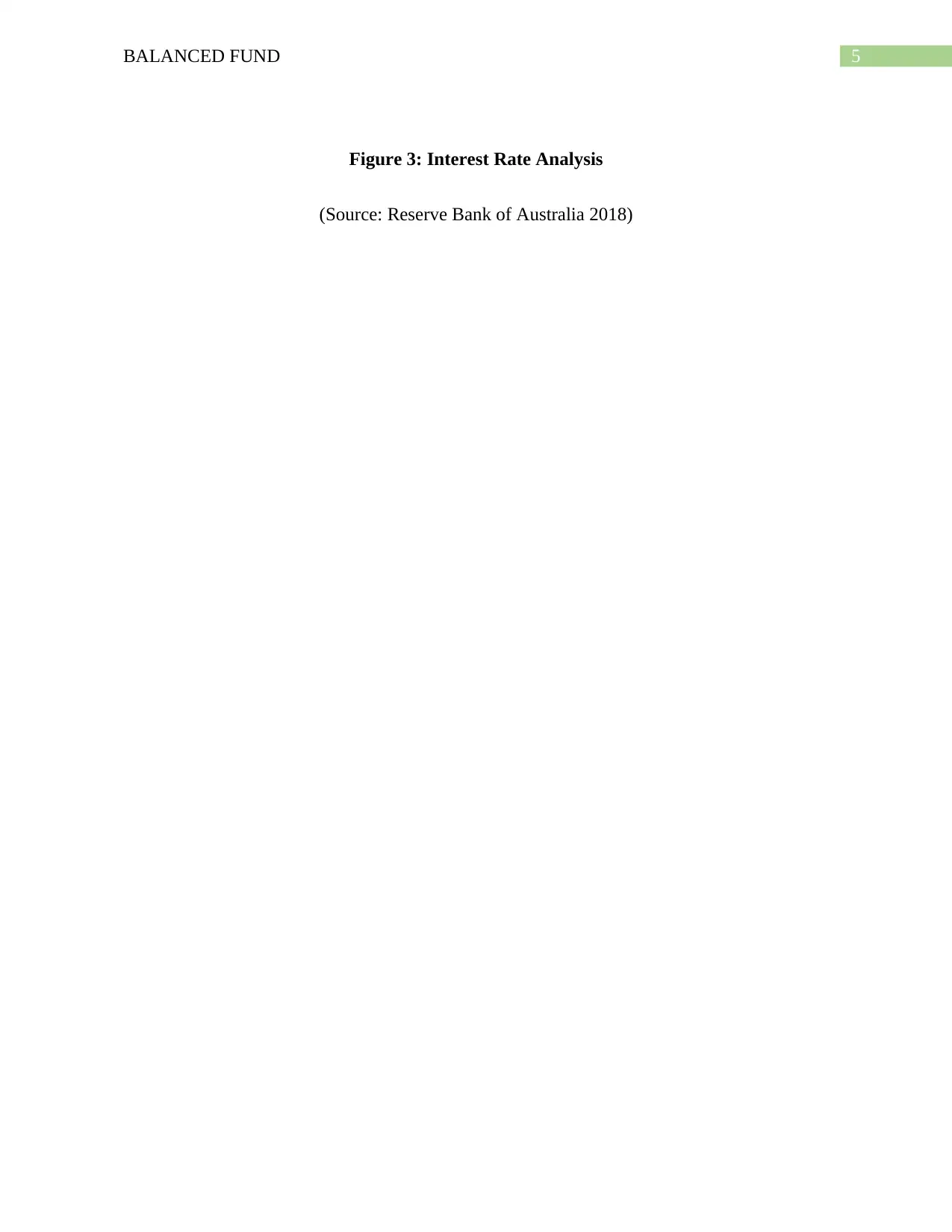
5BALANCED FUND
Figure 3: Interest Rate Analysis
(Source: Reserve Bank of Australia 2018)
Figure 3: Interest Rate Analysis
(Source: Reserve Bank of Australia 2018)
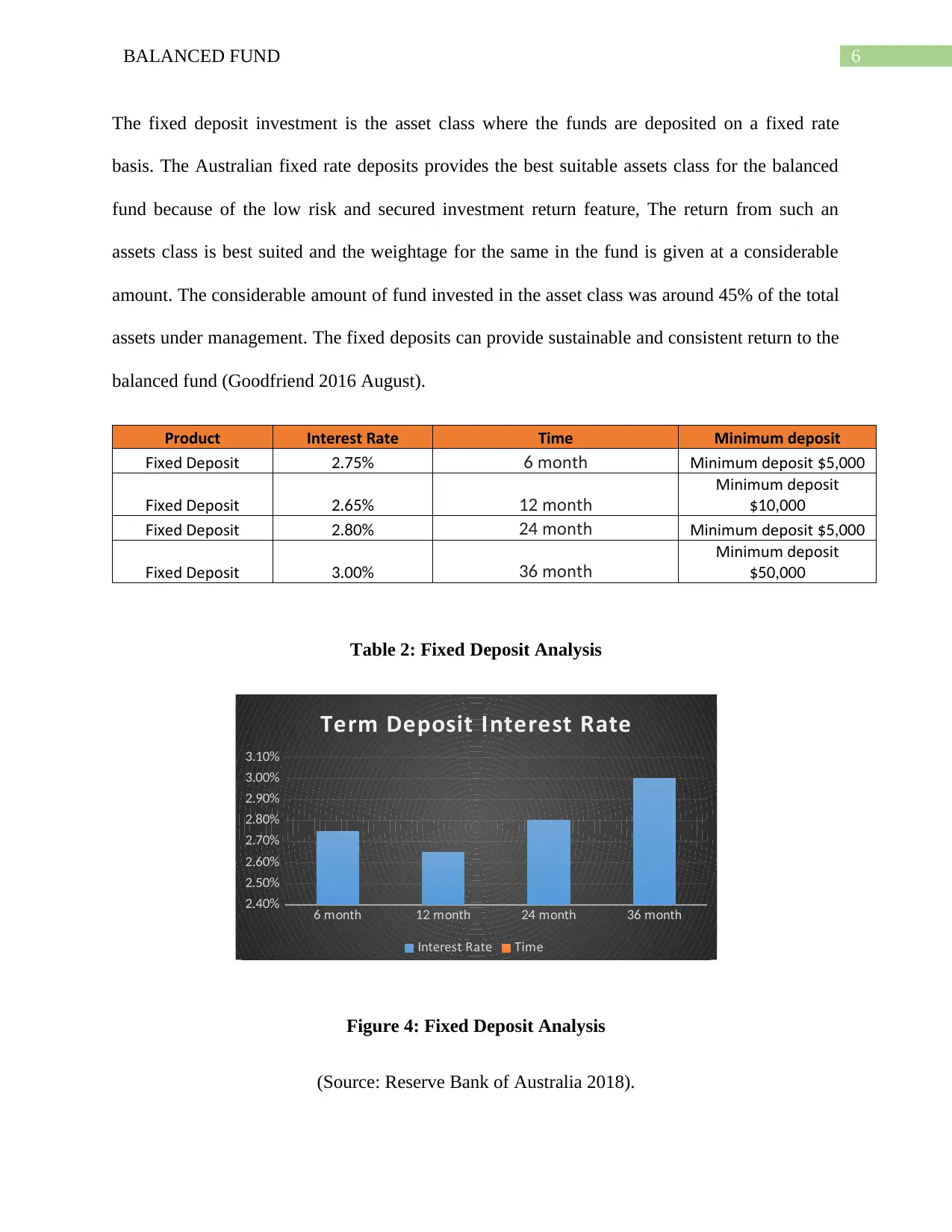
6BALANCED FUND
The fixed deposit investment is the asset class where the funds are deposited on a fixed rate
basis. The Australian fixed rate deposits provides the best suitable assets class for the balanced
fund because of the low risk and secured investment return feature, The return from such an
assets class is best suited and the weightage for the same in the fund is given at a considerable
amount. The considerable amount of fund invested in the asset class was around 45% of the total
assets under management. The fixed deposits can provide sustainable and consistent return to the
balanced fund (Goodfriend 2016 August).
Product Interest Rate Time Minimum deposit
i ed DepositF x 2.75% month6 Minimum deposit $5,000
i ed DepositF x 2.65% month12
Minimum deposit
$10,000
i ed DepositF x 2.80% month24 Minimum deposit $5,000
i ed DepositF x 3.00% month36
Minimum deposit
$50,000
Table 2: Fixed Deposit Analysis
Figure 4: Fixed Deposit Analysis
(Source: Reserve Bank of Australia 2018).
month6 month12 month24 month36
2.40%
2.50%
2.60%
2.70%
2.80%
2.90%
3.00%
3.10%
Term Deposit Interest Rate
nterest RateI imeT
The fixed deposit investment is the asset class where the funds are deposited on a fixed rate
basis. The Australian fixed rate deposits provides the best suitable assets class for the balanced
fund because of the low risk and secured investment return feature, The return from such an
assets class is best suited and the weightage for the same in the fund is given at a considerable
amount. The considerable amount of fund invested in the asset class was around 45% of the total
assets under management. The fixed deposits can provide sustainable and consistent return to the
balanced fund (Goodfriend 2016 August).
Product Interest Rate Time Minimum deposit
i ed DepositF x 2.75% month6 Minimum deposit $5,000
i ed DepositF x 2.65% month12
Minimum deposit
$10,000
i ed DepositF x 2.80% month24 Minimum deposit $5,000
i ed DepositF x 3.00% month36
Minimum deposit
$50,000
Table 2: Fixed Deposit Analysis
Figure 4: Fixed Deposit Analysis
(Source: Reserve Bank of Australia 2018).
month6 month12 month24 month36
2.40%
2.50%
2.60%
2.70%
2.80%
2.90%
3.00%
3.10%
Term Deposit Interest Rate
nterest RateI imeT
Paraphrase This Document
Need a fresh take? Get an instant paraphrase of this document with our AI Paraphraser
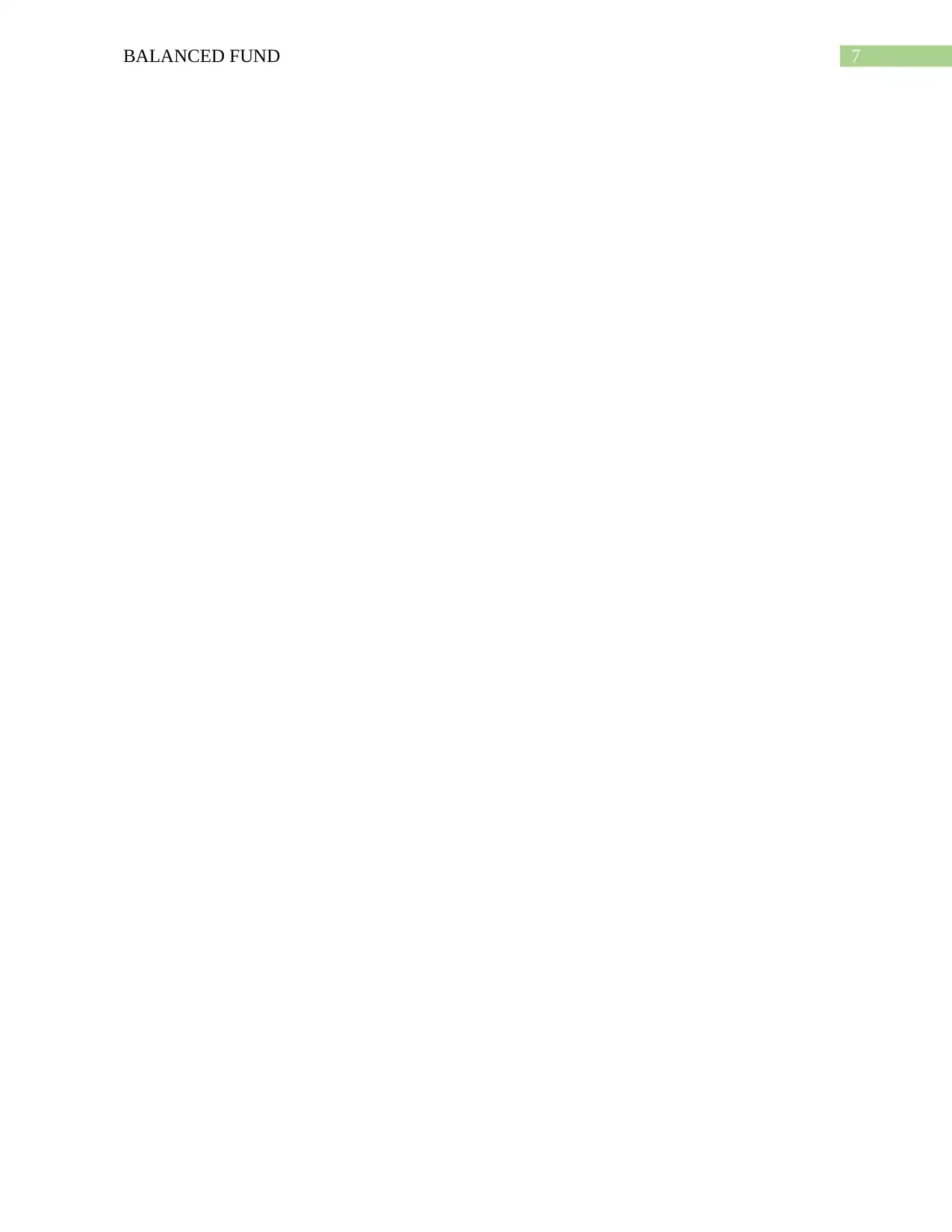
7BALANCED FUND
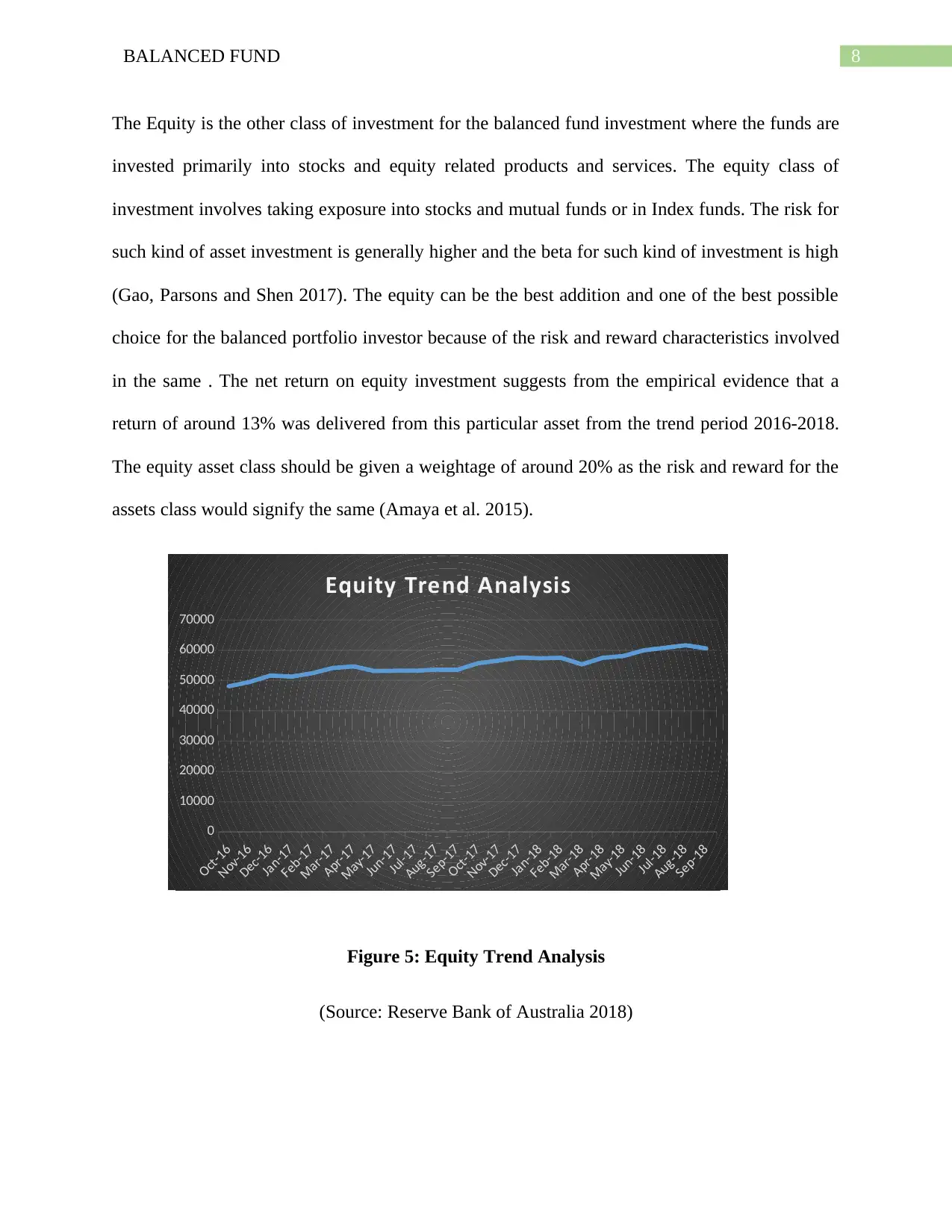
8BALANCED FUND
The Equity is the other class of investment for the balanced fund investment where the funds are
invested primarily into stocks and equity related products and services. The equity class of
investment involves taking exposure into stocks and mutual funds or in Index funds. The risk for
such kind of asset investment is generally higher and the beta for such kind of investment is high
(Gao, Parsons and Shen 2017). The equity can be the best addition and one of the best possible
choice for the balanced portfolio investor because of the risk and reward characteristics involved
in the same . The net return on equity investment suggests from the empirical evidence that a
return of around 13% was delivered from this particular asset from the trend period 2016-2018.
The equity asset class should be given a weightage of around 20% as the risk and reward for the
assets class would signify the same (Amaya et al. 2015).
Figure 5: Equity Trend Analysis
(Source: Reserve Bank of Australia 2018)
ctO -16
ovN -16
Dec-16
anJ -17
ebF -17
Mar-17
Apr-17
May-17
unJ -17
ulJ -17
Aug-17
Sep-17
ctO -17
ovN -17
Dec-17
anJ -18
ebF -18
Mar-18
Apr-18
May-18
unJ -18
ulJ -18
Aug-18
Sep-18
0
10000
20000
30000
40000
50000
60000
70000
Equity Trend Analysis
The Equity is the other class of investment for the balanced fund investment where the funds are
invested primarily into stocks and equity related products and services. The equity class of
investment involves taking exposure into stocks and mutual funds or in Index funds. The risk for
such kind of asset investment is generally higher and the beta for such kind of investment is high
(Gao, Parsons and Shen 2017). The equity can be the best addition and one of the best possible
choice for the balanced portfolio investor because of the risk and reward characteristics involved
in the same . The net return on equity investment suggests from the empirical evidence that a
return of around 13% was delivered from this particular asset from the trend period 2016-2018.
The equity asset class should be given a weightage of around 20% as the risk and reward for the
assets class would signify the same (Amaya et al. 2015).
Figure 5: Equity Trend Analysis
(Source: Reserve Bank of Australia 2018)
ctO -16
ovN -16
Dec-16
anJ -17
ebF -17
Mar-17
Apr-17
May-17
unJ -17
ulJ -17
Aug-17
Sep-17
ctO -17
ovN -17
Dec-17
anJ -18
ebF -18
Mar-18
Apr-18
May-18
unJ -18
ulJ -18
Aug-18
Sep-18
0
10000
20000
30000
40000
50000
60000
70000
Equity Trend Analysis
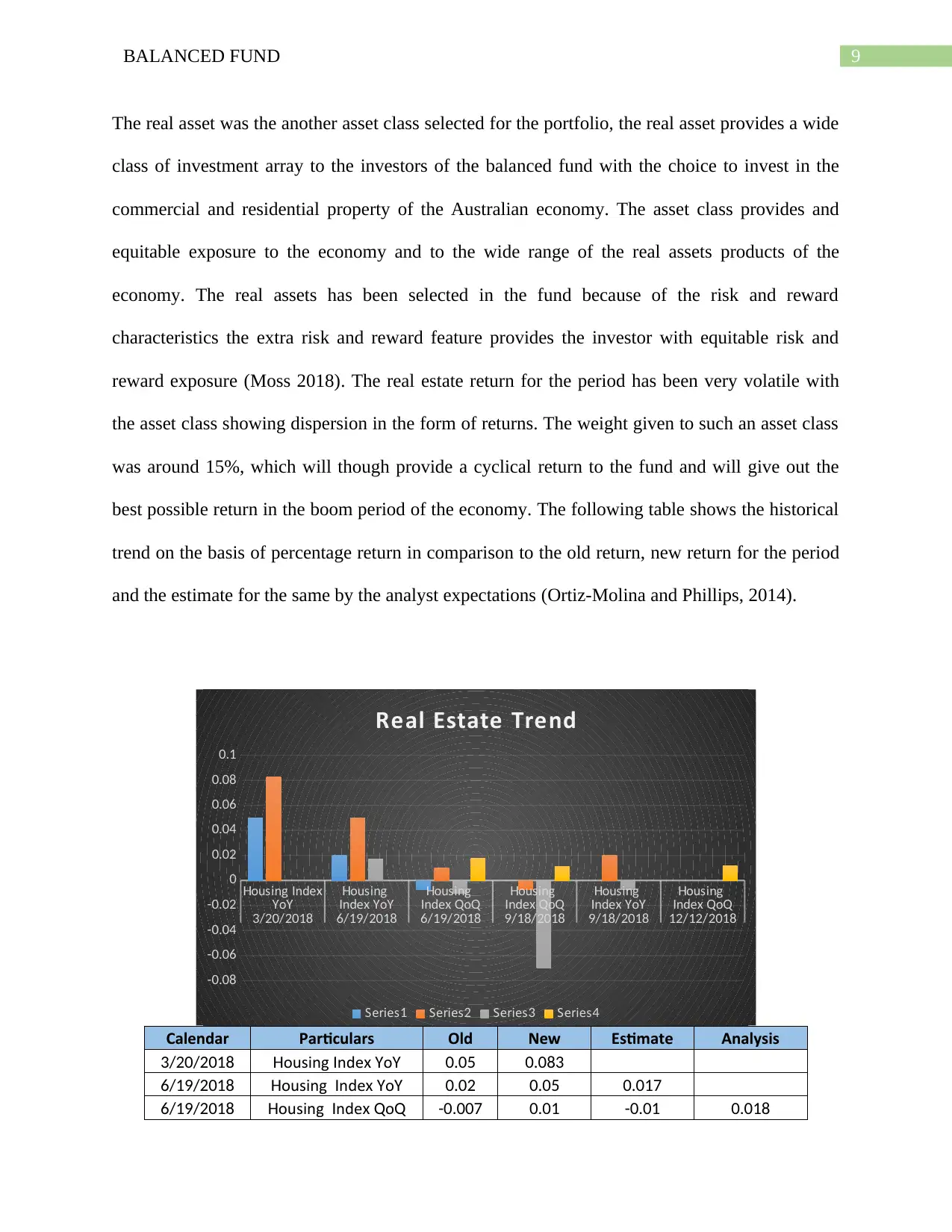
9BALANCED FUND
The real asset was the another asset class selected for the portfolio, the real asset provides a wide
class of investment array to the investors of the balanced fund with the choice to invest in the
commercial and residential property of the Australian economy. The asset class provides and
equitable exposure to the economy and to the wide range of the real assets products of the
economy. The real assets has been selected in the fund because of the risk and reward
characteristics the extra risk and reward feature provides the investor with equitable risk and
reward exposure (Moss 2018). The real estate return for the period has been very volatile with
the asset class showing dispersion in the form of returns. The weight given to such an asset class
was around 15%, which will though provide a cyclical return to the fund and will give out the
best possible return in the boom period of the economy. The following table shows the historical
trend on the basis of percentage return in comparison to the old return, new return for the period
and the estimate for the same by the analyst expectations (Ortiz-Molina and Phillips, 2014).
Calendar Particulars Old New Estimate Analysis
3/20/2018 ousing nde oH I x Y Y 0.05 0.083
6/19/2018 ousing nde oH I x Y Y 0.02 0.05 0.017
6/19/2018 ousing nde oH I x Q Q -0.007 0.01 -0.01 0.018
ousing ndeH I x
oY Y ousingH
nde oI x Y Y ousingH
nde oI x Q Q ousingH
nde oI x Q Q ousingH
nde oI x Y Y ousingH
nde oI x Q Q
3/20/2018 6/19/2018 6/19/2018 9/18/2018 9/18/2018 12/12/2018
-0.08
-0.06
-0.04
-0.02
0
0.02
0.04
0.06
0.08
0.1
Real Estate Trend
Series1 Series2 Series3 Series4
The real asset was the another asset class selected for the portfolio, the real asset provides a wide
class of investment array to the investors of the balanced fund with the choice to invest in the
commercial and residential property of the Australian economy. The asset class provides and
equitable exposure to the economy and to the wide range of the real assets products of the
economy. The real assets has been selected in the fund because of the risk and reward
characteristics the extra risk and reward feature provides the investor with equitable risk and
reward exposure (Moss 2018). The real estate return for the period has been very volatile with
the asset class showing dispersion in the form of returns. The weight given to such an asset class
was around 15%, which will though provide a cyclical return to the fund and will give out the
best possible return in the boom period of the economy. The following table shows the historical
trend on the basis of percentage return in comparison to the old return, new return for the period
and the estimate for the same by the analyst expectations (Ortiz-Molina and Phillips, 2014).
Calendar Particulars Old New Estimate Analysis
3/20/2018 ousing nde oH I x Y Y 0.05 0.083
6/19/2018 ousing nde oH I x Y Y 0.02 0.05 0.017
6/19/2018 ousing nde oH I x Q Q -0.007 0.01 -0.01 0.018
ousing ndeH I x
oY Y ousingH
nde oI x Y Y ousingH
nde oI x Q Q ousingH
nde oI x Q Q ousingH
nde oI x Y Y ousingH
nde oI x Q Q
3/20/2018 6/19/2018 6/19/2018 9/18/2018 9/18/2018 12/12/2018
-0.08
-0.06
-0.04
-0.02
0
0.02
0.04
0.06
0.08
0.1
Real Estate Trend
Series1 Series2 Series3 Series4
Secure Best Marks with AI Grader
Need help grading? Try our AI Grader for instant feedback on your assignments.

10BALANCED FUND
9/18/2018 ousing nde oH I x Q Q -0.007 -0.07 0.011
9/18/2018 ousing nde oH I x Y Y 0.02 -0.007
12/12/2018 ousing nde oH I x Q Q 0.012
Figure 6: Real Estate Trend
(Source: Reserve Bank of Australia 2018).
The Overseas Fixed Deposit Rate is done by investing in countries, which are having better
opportunity of funds investing in a particular fixed scheme presented by different country. The
main advantages is such type of investment in the asset class is the global exposure of
investments in an around via different factors like the macro economic conditions of the country.
The main type of problems associated with such class of investment is that the assets suffers
from country or sovereign risks and global currency fluctuations, which are observed on a global
scale (Du and Schreger 2016). The weightage given to the asset class was around 5% as these
deposits can prove out to be at times risky for the investors where consistency between risk and
return is not observed. Empirical evidence suggests that although the global fixed deposit rates
and returns are stable for fixed deposit type or class of the investment but the wide range of
volatility in the currency may expose the investors of the fund with additional macroeconomic
and country wide risk that would not be risk return trade off in that case (Ong 2018).
The Alternative investment is a new conceit of investment where the traditional assets classes
such as Equity and Bonds have been looked off and a new class of investment like private equity
fund, commodities, hedge funds and others are some of the examples of the alternative source of
investment that the fund manager can select for investment (Jurek and Stafford 2015). The
Private Equity fund, which has been selected as the asset class for our investments into
alternative investment as this type of investment, has the potential to deliver better output and
returns which are way exceptionally beyond the concept of what equity and bond investment
9/18/2018 ousing nde oH I x Q Q -0.007 -0.07 0.011
9/18/2018 ousing nde oH I x Y Y 0.02 -0.007
12/12/2018 ousing nde oH I x Q Q 0.012
Figure 6: Real Estate Trend
(Source: Reserve Bank of Australia 2018).
The Overseas Fixed Deposit Rate is done by investing in countries, which are having better
opportunity of funds investing in a particular fixed scheme presented by different country. The
main advantages is such type of investment in the asset class is the global exposure of
investments in an around via different factors like the macro economic conditions of the country.
The main type of problems associated with such class of investment is that the assets suffers
from country or sovereign risks and global currency fluctuations, which are observed on a global
scale (Du and Schreger 2016). The weightage given to the asset class was around 5% as these
deposits can prove out to be at times risky for the investors where consistency between risk and
return is not observed. Empirical evidence suggests that although the global fixed deposit rates
and returns are stable for fixed deposit type or class of the investment but the wide range of
volatility in the currency may expose the investors of the fund with additional macroeconomic
and country wide risk that would not be risk return trade off in that case (Ong 2018).
The Alternative investment is a new conceit of investment where the traditional assets classes
such as Equity and Bonds have been looked off and a new class of investment like private equity
fund, commodities, hedge funds and others are some of the examples of the alternative source of
investment that the fund manager can select for investment (Jurek and Stafford 2015). The
Private Equity fund, which has been selected as the asset class for our investments into
alternative investment as this type of investment, has the potential to deliver better output and
returns which are way exceptionally beyond the concept of what equity and bond investment
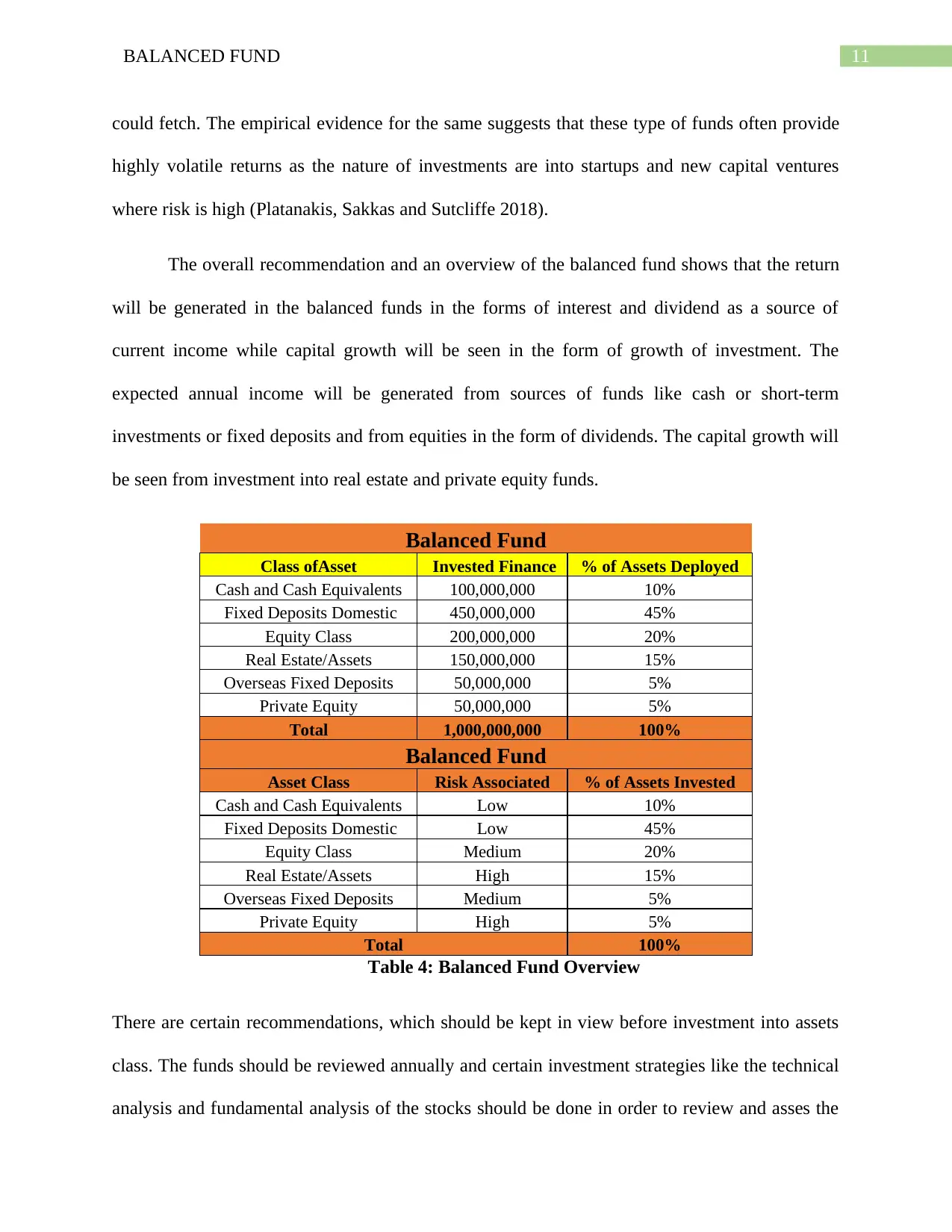
11BALANCED FUND
could fetch. The empirical evidence for the same suggests that these type of funds often provide
highly volatile returns as the nature of investments are into startups and new capital ventures
where risk is high (Platanakis, Sakkas and Sutcliffe 2018).
The overall recommendation and an overview of the balanced fund shows that the return
will be generated in the balanced funds in the forms of interest and dividend as a source of
current income while capital growth will be seen in the form of growth of investment. The
expected annual income will be generated from sources of funds like cash or short-term
investments or fixed deposits and from equities in the form of dividends. The capital growth will
be seen from investment into real estate and private equity funds.
Balanced Fund
Class ofAsset Invested Finance % of Assets Deployed
Cash and Cash Equivalents 100,000,000 10%
Fixed Deposits Domestic 450,000,000 45%
Equity Class 200,000,000 20%
Real Estate/Assets 150,000,000 15%
Overseas Fixed Deposits 50,000,000 5%
Private Equity 50,000,000 5%
Total 1,000,000,000 100%
Balanced Fund
Asset Class Risk Associated % of Assets Invested
Cash and Cash Equivalents Low 10%
Fixed Deposits Domestic Low 45%
Equity Class Medium 20%
Real Estate/Assets High 15%
Overseas Fixed Deposits Medium 5%
Private Equity High 5%
Total 100%
Table 4: Balanced Fund Overview
There are certain recommendations, which should be kept in view before investment into assets
class. The funds should be reviewed annually and certain investment strategies like the technical
analysis and fundamental analysis of the stocks should be done in order to review and asses the
could fetch. The empirical evidence for the same suggests that these type of funds often provide
highly volatile returns as the nature of investments are into startups and new capital ventures
where risk is high (Platanakis, Sakkas and Sutcliffe 2018).
The overall recommendation and an overview of the balanced fund shows that the return
will be generated in the balanced funds in the forms of interest and dividend as a source of
current income while capital growth will be seen in the form of growth of investment. The
expected annual income will be generated from sources of funds like cash or short-term
investments or fixed deposits and from equities in the form of dividends. The capital growth will
be seen from investment into real estate and private equity funds.
Balanced Fund
Class ofAsset Invested Finance % of Assets Deployed
Cash and Cash Equivalents 100,000,000 10%
Fixed Deposits Domestic 450,000,000 45%
Equity Class 200,000,000 20%
Real Estate/Assets 150,000,000 15%
Overseas Fixed Deposits 50,000,000 5%
Private Equity 50,000,000 5%
Total 1,000,000,000 100%
Balanced Fund
Asset Class Risk Associated % of Assets Invested
Cash and Cash Equivalents Low 10%
Fixed Deposits Domestic Low 45%
Equity Class Medium 20%
Real Estate/Assets High 15%
Overseas Fixed Deposits Medium 5%
Private Equity High 5%
Total 100%
Table 4: Balanced Fund Overview
There are certain recommendations, which should be kept in view before investment into assets
class. The funds should be reviewed annually and certain investment strategies like the technical
analysis and fundamental analysis of the stocks should be done in order to review and asses the
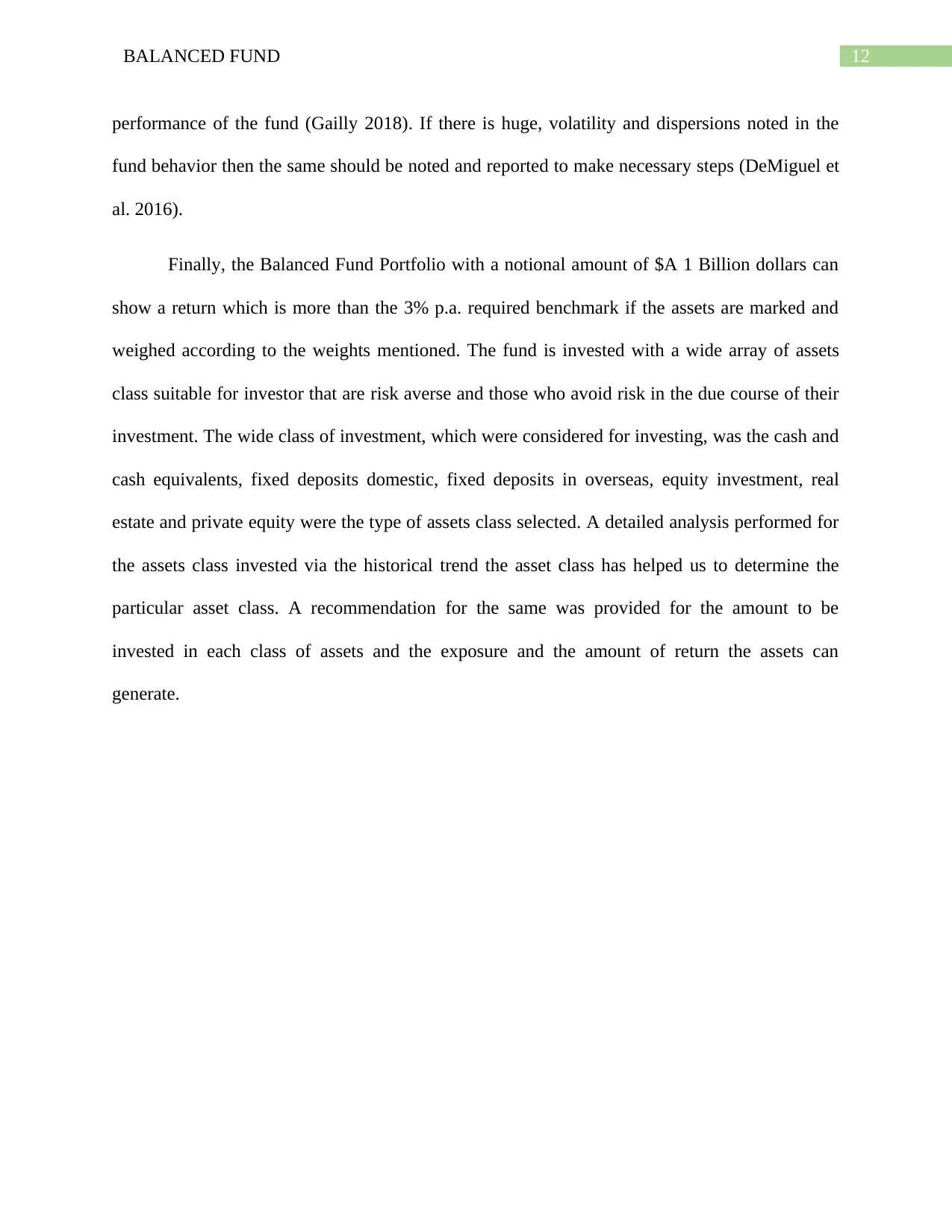
12BALANCED FUND
performance of the fund (Gailly 2018). If there is huge, volatility and dispersions noted in the
fund behavior then the same should be noted and reported to make necessary steps (DeMiguel et
al. 2016).
Finally, the Balanced Fund Portfolio with a notional amount of $A 1 Billion dollars can
show a return which is more than the 3% p.a. required benchmark if the assets are marked and
weighed according to the weights mentioned. The fund is invested with a wide array of assets
class suitable for investor that are risk averse and those who avoid risk in the due course of their
investment. The wide class of investment, which were considered for investing, was the cash and
cash equivalents, fixed deposits domestic, fixed deposits in overseas, equity investment, real
estate and private equity were the type of assets class selected. A detailed analysis performed for
the assets class invested via the historical trend the asset class has helped us to determine the
particular asset class. A recommendation for the same was provided for the amount to be
invested in each class of assets and the exposure and the amount of return the assets can
generate.
performance of the fund (Gailly 2018). If there is huge, volatility and dispersions noted in the
fund behavior then the same should be noted and reported to make necessary steps (DeMiguel et
al. 2016).
Finally, the Balanced Fund Portfolio with a notional amount of $A 1 Billion dollars can
show a return which is more than the 3% p.a. required benchmark if the assets are marked and
weighed according to the weights mentioned. The fund is invested with a wide array of assets
class suitable for investor that are risk averse and those who avoid risk in the due course of their
investment. The wide class of investment, which were considered for investing, was the cash and
cash equivalents, fixed deposits domestic, fixed deposits in overseas, equity investment, real
estate and private equity were the type of assets class selected. A detailed analysis performed for
the assets class invested via the historical trend the asset class has helped us to determine the
particular asset class. A recommendation for the same was provided for the amount to be
invested in each class of assets and the exposure and the amount of return the assets can
generate.
Paraphrase This Document
Need a fresh take? Get an instant paraphrase of this document with our AI Paraphraser
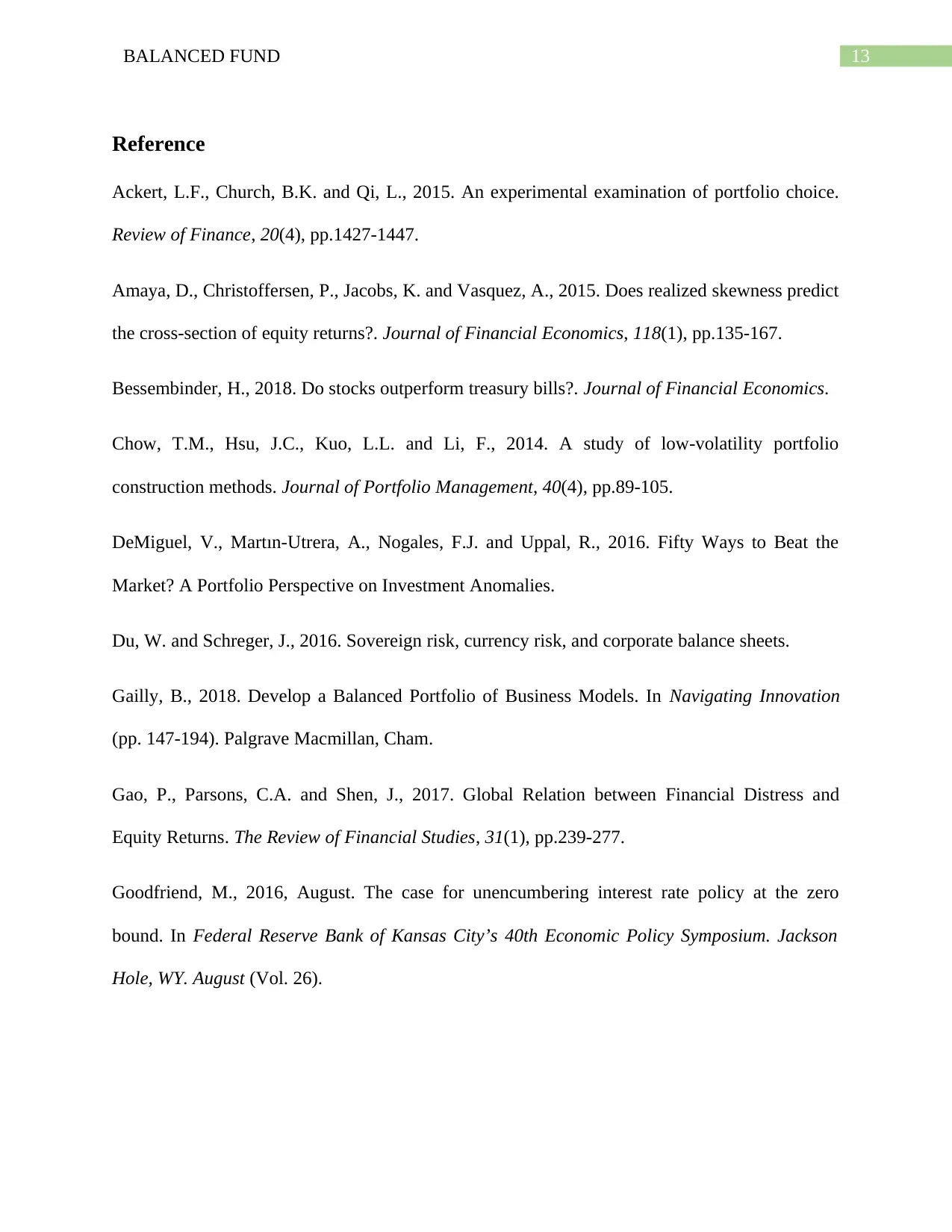
13BALANCED FUND
Reference
Ackert, L.F., Church, B.K. and Qi, L., 2015. An experimental examination of portfolio choice.
Review of Finance, 20(4), pp.1427-1447.
Amaya, D., Christoffersen, P., Jacobs, K. and Vasquez, A., 2015. Does realized skewness predict
the cross-section of equity returns?. Journal of Financial Economics, 118(1), pp.135-167.
Bessembinder, H., 2018. Do stocks outperform treasury bills?. Journal of Financial Economics.
Chow, T.M., Hsu, J.C., Kuo, L.L. and Li, F., 2014. A study of low-volatility portfolio
construction methods. Journal of Portfolio Management, 40(4), pp.89-105.
DeMiguel, V., Martın-Utrera, A., Nogales, F.J. and Uppal, R., 2016. Fifty Ways to Beat the
Market? A Portfolio Perspective on Investment Anomalies.
Du, W. and Schreger, J., 2016. Sovereign risk, currency risk, and corporate balance sheets.
Gailly, B., 2018. Develop a Balanced Portfolio of Business Models. In Navigating Innovation
(pp. 147-194). Palgrave Macmillan, Cham.
Gao, P., Parsons, C.A. and Shen, J., 2017. Global Relation between Financial Distress and
Equity Returns. The Review of Financial Studies, 31(1), pp.239-277.
Goodfriend, M., 2016, August. The case for unencumbering interest rate policy at the zero
bound. In Federal Reserve Bank of Kansas City’s 40th Economic Policy Symposium. Jackson
Hole, WY. August (Vol. 26).
Reference
Ackert, L.F., Church, B.K. and Qi, L., 2015. An experimental examination of portfolio choice.
Review of Finance, 20(4), pp.1427-1447.
Amaya, D., Christoffersen, P., Jacobs, K. and Vasquez, A., 2015. Does realized skewness predict
the cross-section of equity returns?. Journal of Financial Economics, 118(1), pp.135-167.
Bessembinder, H., 2018. Do stocks outperform treasury bills?. Journal of Financial Economics.
Chow, T.M., Hsu, J.C., Kuo, L.L. and Li, F., 2014. A study of low-volatility portfolio
construction methods. Journal of Portfolio Management, 40(4), pp.89-105.
DeMiguel, V., Martın-Utrera, A., Nogales, F.J. and Uppal, R., 2016. Fifty Ways to Beat the
Market? A Portfolio Perspective on Investment Anomalies.
Du, W. and Schreger, J., 2016. Sovereign risk, currency risk, and corporate balance sheets.
Gailly, B., 2018. Develop a Balanced Portfolio of Business Models. In Navigating Innovation
(pp. 147-194). Palgrave Macmillan, Cham.
Gao, P., Parsons, C.A. and Shen, J., 2017. Global Relation between Financial Distress and
Equity Returns. The Review of Financial Studies, 31(1), pp.239-277.
Goodfriend, M., 2016, August. The case for unencumbering interest rate policy at the zero
bound. In Federal Reserve Bank of Kansas City’s 40th Economic Policy Symposium. Jackson
Hole, WY. August (Vol. 26).
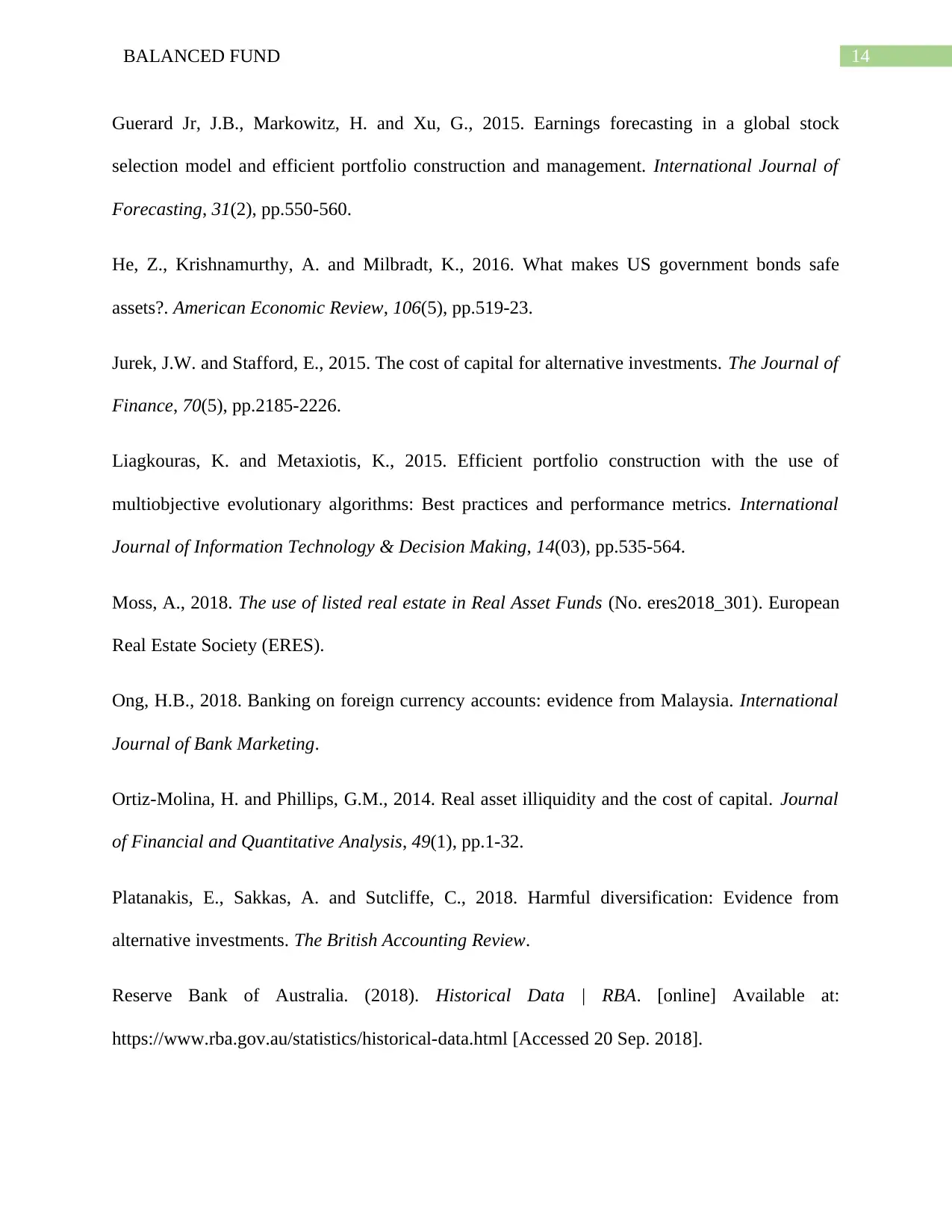
14BALANCED FUND
Guerard Jr, J.B., Markowitz, H. and Xu, G., 2015. Earnings forecasting in a global stock
selection model and efficient portfolio construction and management. International Journal of
Forecasting, 31(2), pp.550-560.
He, Z., Krishnamurthy, A. and Milbradt, K., 2016. What makes US government bonds safe
assets?. American Economic Review, 106(5), pp.519-23.
Jurek, J.W. and Stafford, E., 2015. The cost of capital for alternative investments. The Journal of
Finance, 70(5), pp.2185-2226.
Liagkouras, K. and Metaxiotis, K., 2015. Efficient portfolio construction with the use of
multiobjective evolutionary algorithms: Best practices and performance metrics. International
Journal of Information Technology & Decision Making, 14(03), pp.535-564.
Moss, A., 2018. The use of listed real estate in Real Asset Funds (No. eres2018_301). European
Real Estate Society (ERES).
Ong, H.B., 2018. Banking on foreign currency accounts: evidence from Malaysia. International
Journal of Bank Marketing.
Ortiz-Molina, H. and Phillips, G.M., 2014. Real asset illiquidity and the cost of capital. Journal
of Financial and Quantitative Analysis, 49(1), pp.1-32.
Platanakis, E., Sakkas, A. and Sutcliffe, C., 2018. Harmful diversification: Evidence from
alternative investments. The British Accounting Review.
Reserve Bank of Australia. (2018). Historical Data | RBA. [online] Available at:
https://www.rba.gov.au/statistics/historical-data.html [Accessed 20 Sep. 2018].
Guerard Jr, J.B., Markowitz, H. and Xu, G., 2015. Earnings forecasting in a global stock
selection model and efficient portfolio construction and management. International Journal of
Forecasting, 31(2), pp.550-560.
He, Z., Krishnamurthy, A. and Milbradt, K., 2016. What makes US government bonds safe
assets?. American Economic Review, 106(5), pp.519-23.
Jurek, J.W. and Stafford, E., 2015. The cost of capital for alternative investments. The Journal of
Finance, 70(5), pp.2185-2226.
Liagkouras, K. and Metaxiotis, K., 2015. Efficient portfolio construction with the use of
multiobjective evolutionary algorithms: Best practices and performance metrics. International
Journal of Information Technology & Decision Making, 14(03), pp.535-564.
Moss, A., 2018. The use of listed real estate in Real Asset Funds (No. eres2018_301). European
Real Estate Society (ERES).
Ong, H.B., 2018. Banking on foreign currency accounts: evidence from Malaysia. International
Journal of Bank Marketing.
Ortiz-Molina, H. and Phillips, G.M., 2014. Real asset illiquidity and the cost of capital. Journal
of Financial and Quantitative Analysis, 49(1), pp.1-32.
Platanakis, E., Sakkas, A. and Sutcliffe, C., 2018. Harmful diversification: Evidence from
alternative investments. The British Accounting Review.
Reserve Bank of Australia. (2018). Historical Data | RBA. [online] Available at:
https://www.rba.gov.au/statistics/historical-data.html [Accessed 20 Sep. 2018].
1 out of 15
Related Documents
Your All-in-One AI-Powered Toolkit for Academic Success.
+13062052269
info@desklib.com
Available 24*7 on WhatsApp / Email
![[object Object]](/_next/static/media/star-bottom.7253800d.svg)
Unlock your academic potential
© 2024 | Zucol Services PVT LTD | All rights reserved.




